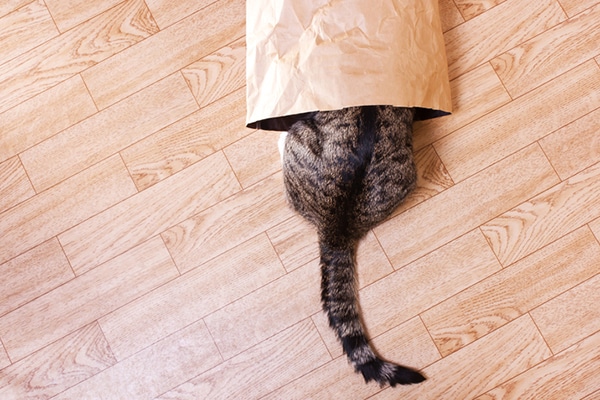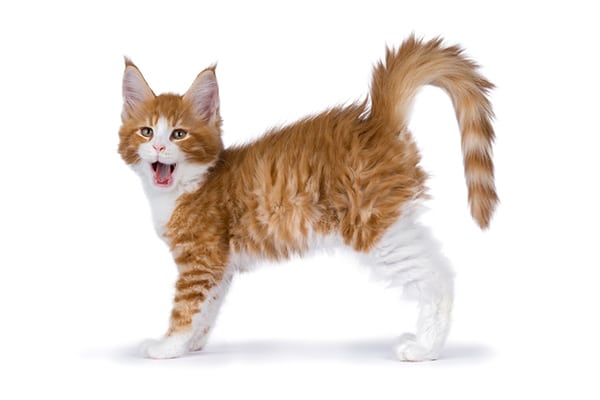The post Cat Tail Wagging: The Meaning of Your Cat’s Different Tail Wags by Angie Bailey appeared first on Catster. Copying over entire articles infringes on copyright laws. You may not be aware of it, but all of these articles were assigned, contracted and paid for, so they aren't considered public domain. However, we appreciate that you like the article and would love it if you continued sharing just the first paragraph of an article, then linking out to the rest of the piece on Catster.com.
Humans usually associate the action of “tail wagging” with dogs. Canines are fairly straightforward with their tail communication. Cats, however, are way more subtle in their body language and cat tail wagging is very nuanced.
Related: 6 Ways to Talk to Your Cat
Marilyn Krieger, Certified Cat Behavior Consultant and author, says, “Although tails are expressive, eyes, ears and body positions combined with the tail language paint a more complete picture of how cats feel.” Cat tail wagging can mean many different things. Here’s how to decipher the messages sent by cat tail wagging!

A cat thrashing his tail means he wants to be left alone. Photography ©Alexmia | Thinkstock.
1. What “The Swish” Means
Marilyn Krieger advises, “The direction and speed [with] which cats move and swish their tails conveys their feelings. When felines thrash their tails quickly back and forth, it indicates that they are unhappy and want to be left alone. Tails that move slowly from left to right often indicate that cats are mildly annoyed. Sometimes, cats who are playing will swish their tails from side to side before pouncing.” This means we should pay attention to the way our cats swish their tails and not make assumptions.
2. What “The Twitch” Means in Cat Tail Language
We’ve all seen this type of cat tail wagging: A cat is sitting on a windowsill concentrating on nearby birds or rodents, when her tail begins twitching. It’s not the exactly the same movement as the previously mentioned “thrashing,” but it may look similar. Her ears, eyes and vocalizations will indicate if she’s upset or simply maintaining laser-sharp focus on a squirrel. As with the thumping, the twitch also carries the message, “leave me alone.”
3. What “The Quiver” Means
A “quiver” is a quick, tiny cat tail wagging action. When your cat is excited to see you, she may approach you with her tail in a vertical position, with just the tip of it making quick, little quivering motions, similar to a rattlesnake’s tail. Unlike the snake’s warning signal, a quivering kitty tail is a welcome sight and is typically accompanied by purring, face rubbing and sometimes even happy vocalizations. Return the greeting, even if you can’t quite do the tail-shaking thing.
4. What “The Sleepy Flick” Means
Unlike dogs, who are more than happy to come when called, cats like to mull over the situation and decide if we’re worth their time at that exact moment. When food is involved, there’s typically no question — all they have to hear is the pop-top of a can and they race into the kitchen like a baseball player sliding into home base.
Other times, if they’re sleeping when we call their names, they like to play games. Instead of blatantly acknowledging us, they choose to meet us with a single — sometimes ever-so-subtle — flick of a sleepy tail. This is cat tail wagging that means, “Yeah, I hear you — I’m just choosing to ignore you.”
This type of cat tail wagging is actually a sign of contentment because your cat is telling you that she feels comfortable remaining asleep in your presence. The bottom line, however, is that cats are going to do everything on their terms, which is no surprise to anyone who shares their lives with a kitty.

Paying attention to how your cat wags her tail will help you better understand your kitty. Photography ©Nynke van Holten | Thinkstock.
The Bottom Line on Cat Tail Wagging
A cat’s tail is really a barometer for her feelings. Cat tail wagging is a way to communicate those feelings with us, but we must consider the entire picture, including non-tail body language and overall demeanor, before accurately interpreting it. When we learn to read the messages our cats are sending us, we will respond accordingly and develop a trusting, respectful relationship with our beloved felines.
Top photograph: GlobalP | Thinkstock.
This piece was originally published in 2017.
Read Next: What Do Different Cat Meow Sounds Mean?
The post Cat Tail Wagging: The Meaning of Your Cat’s Different Tail Wags by Angie Bailey appeared first on Catster. Copying over entire articles infringes on copyright laws. You may not be aware of it, but all of these articles were assigned, contracted and paid for, so they aren't considered public domain. However, we appreciate that you like the article and would love it if you continued sharing just the first paragraph of an article, then linking out to the rest of the piece on Catster.com.
Angie Bailey